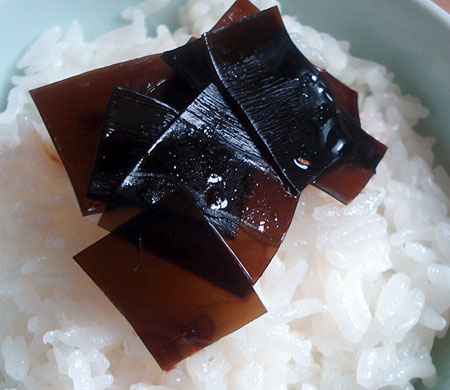How to: Homemade shio kombu or kombu no tsukudani
Kombu, the leathery seaweed that is used to make dashi stock, is packed full of umami. A traditional way to prepare it is as shiokombu (salty kombu) or kombu no tsukudani. Tsukudani is a method of cooking something with soy sauce, sake and/or mirin, and sugar until it's very dark, quite salty and sweet too. It's a preserving method, since the salt and sugar greatly increase the keeping qualities of the food.
Kombu no tsukudani can be tucked into the corner of a bento box to add a little variety. It's also a good onigiri filling. Properly made and stored in the refrigerator, it keeps almost forever.
It does take a while to cook, depending on how tough the kombu is. It's worth making if you think commercial kombu no tsukudani is too salty or too sweet, or too expensive.
It can be made from unused dry kombu or kombu that's been used once to make dashi. I've given instructions for both.
Kombu no tsukudani or shiokombu
Since kombu comes in all sizes, I've given weight amounts here. You can halve the amounts if this seems like too much to make at once.
- 100g / 3 1/2 oz dry kombu seaweed, ideally one that is thick and covered with a fine whiteish powder
- 4 Tbs (or more) tamari soy sauce or dark soy sauce
- 2 Tbs. rice vinegar (or white wine vinegar)
- 6 Tbs. sake
- 2 Tbs. mirin
- 2 Tbs. (or more) sugar
- 1 tsp. of grated ginger juice (grate ginger and squeeze out the juice) - optional
Equipment needed: a heavy bottomed saucepan. (A Le Creuset-type enamelled cast iron one is ideal.)
Inspect the kombu - if it has sand or dirt on it (not the natural fine white powdery coating), wash it off. (Nowadays it's rare to find sand etc. on commercially available kombu, but if you buy it from a local producer or even gather it yourself, you'll have to deal with that.)
Soak the kombu in water to cover just until it's soft enough to cut. Drain, making sure the water drips back into whatever you were soaking the kombu in, and cut the kombu into bite-sized pieces.
Put the kombu back in the soaking water and add vinegar. Leave for an hour or more. The kombu should feel a bit slimy at the end of the soaking period. The vinegar helps to tenderize it. Some thicker kinds of kombu may require a longer soak.
Put the kombu and soaking liquid into the heavy pan. Add the other ingredients. Bring up to a simmer then lower the heat - the surface of the liquid should be barely bubbling. Add water if it starts to dry out.
Simmer slowly like this until the kombu is very soft - it should seem almost too soft, since when it cools the kombu will stiffen up a bit. By this point there should be very little liquid in the pan. Taste the kombu, and add a bit more soy sauce or sugar if needed, and simmer some more. When it's done the kombu will be shiny and caramelized and have a translucent quality, like thin slices of dark caramel or tortoiseshell.
Store, covered, in the refrigerator.
You can optionally add a couple of handfuls of bonito flakes near the end of the cooking process. Mix in well, and let it cook down until it's almost dry. (Adding bonito flakes will make it no longer vegan of course, since bonito is a fish.)
You can also add red pepper flakes or shichimi (or nanami!) tohgarashi for a bit of spice.
Using pre-used kombu
You can use kombu that was used for making dashi, either the regular kind or the vegetarian version. What I do is to cut up the soaked kombu and store it in a container in the freezer until I have enough to make kombu no tsukudani. There is less umami than in the version made from unused kombu, but it's still tasty. Here are the seasonings proportions:
- 1 cup (240ml) of cut-up, defrosted, pre-used kombu
- 1/2 Tbs. vinegar
- Water to cover
- 1-2 Tbs (or more, to taste) tamari or dark soy sauce
- 3 Tbs. sake
- 1 Tbs. mirin
- 1 Tbs. sugar
- About 1/2 tsp. of grated ginger juice.
This will need less soaking time, since it's already been soaked, and the freezing and de-frosting would have broken down the fibers a bit. Proceed as with the recipe above.
Instant soup from kombu no tsukudani
Put a little homemade or commercial kombu no tsukudani into a mug or small bowl, and add hot water. Optionally add a little julienned fresh ginger. Stir and let sit for a few minutes. It makes an interesting clear soup. (Confession: I used to hate this when I was a kid, but now I rather like it. It may take some getting used to.)
If you enjoyed this article, please consider supporting this site by becoming my patron via Patreon.

